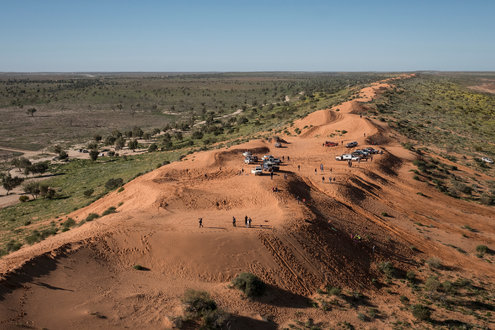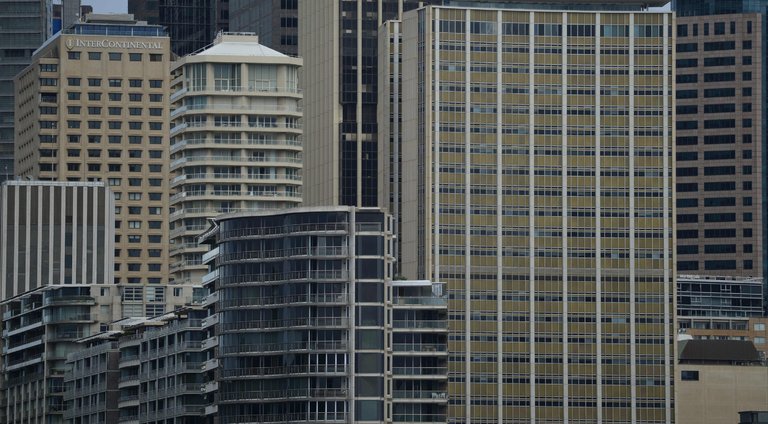
“Australia has some of the world’s highest household debt, especially comparing debt to incomes & GDP. Disaster looms if there is a serious economic downturn. Even though we don’t have to put aside hundreds of thousands of dollars for college degrees, or tens of thousands for health insurance, our mortgage debt is staggering. For those who are not owners, property boom is already dividing nation along lines of age and class. For young people, property prices represent dashed hopes and looming intergenerational battle. We have so far avoided hollowing out of middle class suffered by other countries like the US. Australia has one of the world’s highest percentages of middle-class people, at ~56% of the population. But all that is in danger of disappearing, because successive governments have been fueling a rat race when they should have been building a society.” Top, beautiful Australian “countryside”. Bottom, Sydney, earlier this month, where people are racking up extreme debt to buy homes.
“Despite what you may have heard about snakes and spiders and sharks, the remarkable thing about Australia is not its danger but its safety.
At its best, this is a peaceful nation, with health care and education for almost everyone,
that has enjoyed over the past two decades the longest period of economic expansion of any developed country in modern history.
Our cities are regularly judged to be among the most livable in the world.
But we are in danger of stuffing it up, which is an Australian way of saying we may be ruining it all.
In the past 20 years, Australia has become a nation where getting ahead is a national obsession,
partly because we have come to expect a world where the natural course of events is to become a little bit richer each year.
The winnings of our repeated economic booms have been squandered on inflationary policies that fuel the rat race.
What we are discovering is that when you have a nation full of people trying to get to the top,
eventually most of the population is forced to run just to keep up.
Our enviable quality of life is at risk.
Consider what has happened with the housing market,
Australia being a country where real estate is not just a place to live but a ticket to prosperity and a statement of taste and values.
Generous tax breaks for homeowners and real estate investors have fueled the market to the point where
the median price of a house in Sydney, our largest metropolis, is $1.1 million Australian dollars, or about $824,000.
An entire genre of newspaper writing is dedicated to telling Australians what they could buy for the same money in other parts of the world —
a small chateau in the South of France, even an apartment in Manhattan, for the price of an ugly brick house 40 minutes’ drive from the center of the city.
We watch shows like “Million Dollar Listing Los Angeles” and laugh.
So even though Australians do not have to put aside many hundreds of thousands of dollars for college degrees,
or tens of thousands of dollars for health insurance,
we are still in huge debt through our mortgages.
Australia has some of the highest household debt in the world, especially if you compare our debt to our incomes and G.D.P.
We are poised for disaster if there is a serious economic downturn.
Even for those lucky enough to own their own home, there is a fool’s-gold feel to this property boom.
After all, if you own a three-bedroom house five miles from the city and it increases in value by 50 percent,
that means you still have only enough money to buy a three-bedroom house five miles from the city.
This is not so much rising wealth as glorified inflation.
And for those who are not owners?
The property boom is dividing the nation along lines of age and class.
For young people, property prices represent dashed hopes and a looming intergenerational battle.
Consider a recent furor when an older demographer suggested in jest that young people would be better able to save for a house were they not wasting their money buying avocado toast at hipster cafes.
It is a familiar line of attack here, young people being told to stop wasting their money at cafes.
No matter that you would need to forgo 31,429 flat whites to pay a 10 percent deposit on the typical home in Sydney.
Millennials, sick of being told that they don’t know how good they have it, may well point out that
Australia is home to some of the most spoiled baby boomers in the world.
Many retirees divide their time between cruise holidays overseas and subsidized medical appointments here,
all the time complaining that it is the young people who don’t realize how good they have it.
Aside from tax policies that encourage speculation, other policies show
successive governments have been fueling a rat race when they should have been building a society.
Over the past two decades, federal government funding of private schools has expanded,
including to those with very high fees and swimming pool complexes, beautiful gardens and performing arts centers, further dividing the country.
Many middle-class parents have become anxious about sending children to the local public high school,
fearing that they will lag behind their peers at schools that are expensive or academically selective.
We need to rediscover our egalitarian roots.
It is true that Australian culture can be anti-intellectual.
We can deride achievement and cut down those who succeed, in a phenomenon we call tall poppy syndrome.
But the egalitarian values of our society should not be discounted.
In fact, it is on the matter of egalitarianism that Australia has made some of its most important intellectual contributions to the world.
Australia was one of the first countries to institute a living minimum wage,
in a famous court case back in 1907 regarding the employees of the Sunshine Harvester Works.
The court decided that an unskilled worker should be paid enough to meet the needs of “a human being living in a civilized community,”
which included keeping his family in “frugal comfort.”
The cultural effects of this decision —
the idea that every worker should have a decent standard of living —
have been at least as great as the legal ramifications.
Australia enjoys a relatively high minimum wage today of 17.70 Australian dollars, or about $13.25, per hour.
We have so far avoided the hollowing out of the middle class suffered by other countries like the United States.
Australia has one of the world’s highest percentages of middle-class people,
with about 56 percent of the population falling into this category,
according to a 2016 Credit Suisse Global Wealth Report.
Egalitarianism has been a major contributing factor to the quality of life we enjoy in our society, including for those who are better off.
We have low crime rates.
Few of us fear that medical bills will lead to bankruptcy as we have universal health care.
Our university fees are rising, but we can pay the money back to the government over time —
and only once we are earning a decent wage.
We need to remember what makes Australia a fairy tale — and protect it.”
Source: The End of the Australian Dream? – The New York Times
